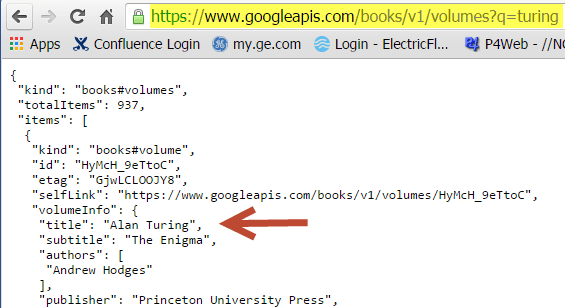In the past, I’ve written a few posts on how to get started using Rest Assured. Today I wanted to go over a new feature — measure response time — that was just introduced in the REST Assured 2.8.0 version released on December 12.
This might not seem like a big change, but for my team, it is, because we sometimes have requirements that need to meet a certain time threshold. Until now we had to create our own function to do this but the build in REST-assured version is much more elegant and easier to use than our implementation.
So let’s take a look at how to use REST-assured to measure response times from a REST service. For this example, I’ll be using my favorite REST API to work with Google Books.
- Open a browser and enter the following URL: https://www.googleapis.com/books/v1/volumes?q=turing
We are going to work with this request and verify that the response returns the first title element value Alan Turing. We are also going to make sure that the response returns in the expected time.

- First, create a new Maven Java project and make sure to add the rest-assured 2.8.0 dependency info in your pom.file
- Next, create a new class called ResponseTime
- Import the following
import org.junit.Test; import com.jayway.restassured.RestAssured; import static com.jayway.restassured.RestAssured.get; import static com.jayway.restassured.RestAssured.given; import static org.hamcrest.Matchers.equalTo; import static org.hamcrest.Matchers.lessThan;
- Create a method simpleExample with a jUnit @Test annotation
- Enter the following:
String json = get("volumes?q=turing").asString();
System.out.println(json);
given().
parameters("q","turing").
when().
get("volumes").
then().
body("items.volumeInfo.title[1]", equalTo("Alan Turing") ).
and().time(lessThan(10L));
- Run the test
- The test should fail with the message
“java.lang.AssertionError: 1 expectation failed. Expected response time was not a value less than <10L> milliseconds, was 765 milliseconds (765 milliseconds).”
- Cool once we know that it’s working; enter the value 1000 milliseconds and rerun. This time it should now pass.
Here is the full code for the ResponseTIme Class:
import org.junit.Test;
import com.jayway.restassured.RestAssured;
import static com.jayway.restassured.RestAssured.get;
import static com.jayway.restassured.RestAssured.given;
import static org.hamcrest.Matchers.equalTo;
import static org.hamcrest.Matchers.lessThan;
public class ResponseTIme {
@Test
public void simpleExample(){
RestAssured.baseURI = "https://www.googleapis.com/books/v1/";
String json = get("volumes?q=turing").asString();
System.out.println(json);
given().
parameters("q","turing").
when().
get("volumes").
then().
body("items.volumeInfo.title[1]", equalTo("Alan Turing") ).
and().time(lessThan(1000L));
}
}
More Rest-Assured Info
For more info on the new rest-assured response time feature and all the other cool new features check out
https://github.com/jayway/rest-assured/wiki/Usage#measuring-response-time
REST-ASSURED – HOW TO POST A JSON REQUEST
REST-assured How to Check Response Times
REST Testing with Java Part Two: Getting Started with Rest-Assured






Comments are closed.